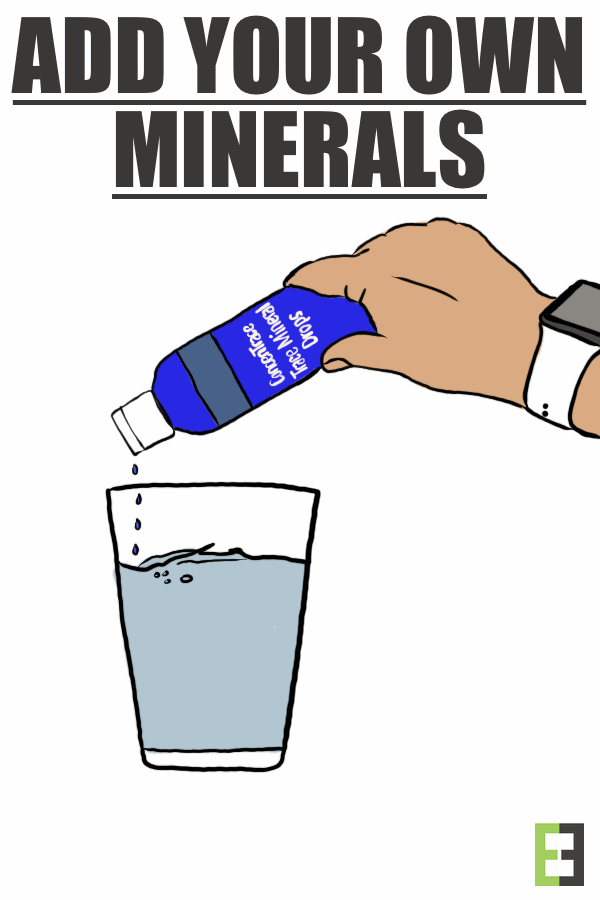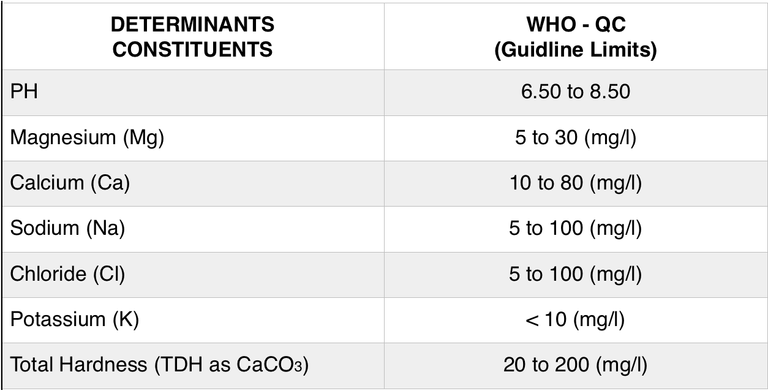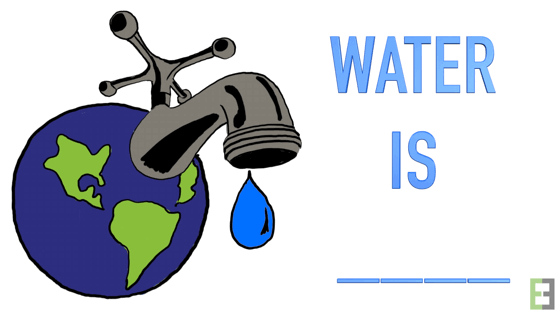Our modern day water supplies are often riddled with contaminants through pollution.
To combat the mess, many public water supplies are treated through the process of demineralization or water softening. These procedures require techniques such as reverse osmosis to rid the water of the harmful substances in them. Unfortunately, these methods also remove beneficial minerals and trace elements from the water. Our bodies rely on these micro-nutrients for many biochemical processes.
Mineral poor water is also highly unstable and corrosive to the materials it comes in contact with.
Source and Pollutants:
Drinking water comes from either groundwater, such as wells and boreholes, or from surface water like dams and rivers.

With all this contamination taking place, the need for water purification is on the rise. According to (World Health Organization, 2015) there are more than half a million mortalities per year caused by contaminated drinking water. It is, thus, wishful thinking to believe that your local well has no contaminants in it.
It is our human right to have access to clean water. The UN general assembly set it as one of their 'millennium development goals' to improve the range of safe drinking water to the public. The US Environment Protection Agency (EPA) prioritized setting regulations on the number of contaminants such as arsenic, cyanide, mercury, etc., that are present in public drinking water, in their Safe Drinking Water Act (SDWA).
The levels and ratios of essential minerals such as magnesium, calcium, and sodium, is secondary, in importance, to contaminants according to that same act.
Preparation:
All prepared/treated water will first go through the process of disinfection using chlorination and ozonation.

These processes all serve their purpose of removing unwanted substances from the water. Unfortunately, these methods also remove essential minerals and trace elements, used by the body.
Benefits of minerals:
The essential minerals, found in abundance within the unprocessed water are Sodium, Magnesium, and Calcium.
Sodium helps regulate fluid retention and water balance in the body. It is essential to every muscle contraction and neural impulse. Sodium is also known as an electrolyte which is lost through sweat and physical activity. Consumption of water is supposed to help replenish this deficit.
Magnesium regulates over 300 enzymes across all the major systems of our body, which translates to thousands of biochemical processes. From our DNA repair mechanisms to our metabolism of energy and insulin sensitivity, they all require magnesium to properly function. Sadly, 48% of the US population are consuming suboptimal amounts of magnesium on a daily basis (Rosanoff, Weaver and Rude, 2012). Perhaps the growing consumption of demineralized water is contributing to the deficiency of this mineral.
Calcium, as many know, is highly beneficial to bone and teeth health. This mineral also plays a role in the process of blood clotting and cell signaling. Calcium happens to rely on the presence of magnesium to perform many of its functions, though.
It is not a coincidence that these minerals are found together in water.
Interestingly, the elements found in water are free ions and therefore quickly absorbed by the body. This bio-availability of mineral water is superior when compared to over the counter nutritional supplements. Based on this fact alone, we can see the importance of drinking water to reach our daily allowance of these minerals.
Water, high in minerals is considered ‘hard.’ One of the overlooked benefits of 'hard water' is how stable its molecules are.
Mineral deficient water is very unstable and tends to be more corrosive on materials that they are stored in or passed through. There were three instances of lead poisoning in infants due to drinking water in the USA between 1993-1994. When investigated, all the cases were found to have mineral deficient water involved, which through its corrosive nature, pulled lead from the pipes.
According to a study by (Kozisek, n.d.), the use of mineral deficient (soft) water, while cooking, has been shown to remove up to 70% more minerals from food than mineral rich (hard) water.
Conclusion and Discussion:

It is, therefore, up to us, as the consumers, to ensure that the water is not only safe but, also healthy to drink. There are various ways we can do this.
First, we must have a guideline for the quantities of minerals that drinking water must contain. These instructions must compare to the mineral contents featured on the labels of bottled water or the municipal water in your area. The World Health Organisation has provided the recommended ranges for us. The table below contains the most important.

If the water does not fall within the ranges provided, then, it is necessary to find an available supply that does. Alternatively, we can supplement/replenish our water with the bio-available forms of minerals and trace elements. 'Concentrace' is a liquid form of a mineral supplement designed for this purpose.
As previously mentioned, safe, uncontaminated drinking water is our right. Healthy, mineral-rich drinking water, is, however, our responsibility.
Follow me at @exercisinghealth
Sources:
Ancient-minerals.com. (2016). Causes of a Lack of Magnesium | Ancient Minerals. [online] Available at: http://www.ancient-minerals.com/magnesium-deficiency/causes-depletion.
Azoulay, A., Garzon, P. and Eisenberg, M. (2001). Comparison of the mineral content of tap water and bottled waters. J Gen Intern Med, [online] 16(3), pp.168-175. Available at: http://www.ncbi.nlm.nih.gov/pmc/articles/PMC1495189/
Barnes, Z. (2015). Magnesium, the invisible deficiency that hurts health. [online] CNN. Available at: http://edition.cnn.com/2014/12/31/health/magnesium-deficiency-health/
Cdc.gov. (2016). Water Sources | Public Water Systems | Drinking Water | Healthy Water | CDC.[online] Available at: http://www.cdc.gov/healthywater/drinking/public/water_sources.html
Conserve-Energy-Future. (2013). Sources and Causes of Water Pollution - Conserve Energy Future. [online] Available at: http://www.conserve-energy-future.com/sources-and-causes-of-water-pollution.php
Epa.gov. (2016). How EPA Regulates Drinking Water Contaminants | Regulation Development for Drinking Water Contaminants | US EPA. [online] Available at: https://www.epa.gov/dwregdev/how-epa-regulates-drinking-water-contaminants
Groundwater.org. (2016). groundwater contamination. [online] Available at: http://www.groundwater.org/get-informed/groundwater/contamination.html
Gupta, V., Ali, I., Saleh, T., Nayak, A. and Agarwal, S. (2012). Chemical treatment technologies for waste-water recycling—an overview. RSC Advances, [online] 2(16), p.6380. Available at: http://pubs.rsc.org/en/Content/ArticleLanding/2012/RA/c2ra20340e#!divAbstract
Kiefer, D. (2016). Magnesium Deficiency: Is Your Bottled Water Killing You? - Life Extension.[online] LifeExtension.com. Available at: http://www.lifeextension.com/magazine/2007/2/report_water/Page-01
Kozisek, F. (n.d.). health risk of drinking demineralised water. 1st ed. [ebook] Czech Republic:National Institute of Public Health, pp.148-163. Available at: http://www.who.int/water_sanitation_health/dwq/nutrientschap12.pdf
Negoianu, D. and Goldfarb, S. (2008). Just Add Water. Journal of the American Society of Nephrology, 19(6), pp.1041-1043.
Nesc.wvu.edu. (2016). Tech Brief Fact Sheets - Drinking Water. [online] Available at: http://www.nesc.wvu.edu/techbrief.cfm
Rosanoff, A., Weaver, C. and Rude, R. (2012). Suboptimal magnesium status in the United States: are the health consequences underestimated?. Nutrition Reviews, 70(3), pp.153-164.
Who.int. (2016). WHO | Nutrient minerals in drinking-water. [online] Available at: http://www.who.int/water_sanitation_health/gdwqrevision/nutminerals/en/
World Health Organization. (2015). Drinking-water. [online] Available at: http://www.who.int/mediacentre/factsheets/fs391/en/
*All images were created by @exercisinghealth

Another pollutant to water I might add is fluoride . Water fluoridation is practiced in America. Fluoride is also added to tooth paste . Their argument is that fluoride helps to protect the teeth. Does it ?????
One danger is that fluoride tend to accumulate into our pineal gland which will have negative effect on our brain activity.
There are many references to this on the web. Here's one:
http://fluoridealert.org/issues/water/
I haven’t done extensive research on fluoride, but, I am aware that too much of it can cause adverse effects to the body. At the end of the day, the more we manipulate things away from their natural forms, the worse they turn out.
Perhaps purification plants could clean and remove the harmful substances from the water, then, add back a balanced formula or minerals and trace elements. I believe Nestle do this to their in their water production facilities.
The extra cost of the second step is probably not attractive to most companies though
In my country they sell fluoride free tooth paste. Seems to be a new trend here. My whole family have stopped using brands with fluoride.
Question is why would people produce fluoride free tooth paste while the mainstream highly advocate it. Do they know something we don't. I would like to share some related links as below:
https://wakeup-world.com/2016/11/02/pineal-gland-science-dmt-fluoride-and-activation/
https://www.globalhealingcenter.com/natural-health/how-fluoride-damages-pineal-gland-health/
https://www.vice.com/sv/article/kwz5m3/why-are-governments-putting-fluoride-in-our-water-sheeple
Tell me what you think.
In the near future, wars will not be fought over oil, but clean water.
Unfortunately, I agree with you. It is a scary thought indeed.
This is one reason to research and implement permaculture. They've re-greened the deserts into micro-climates which create humidity, water and eventually flowing streams. Truly hopeful.
Thank you for this post! When I was younger, I'd have the impression that "pure" water was the best water because that implies it is free of chemicals or toxins - but it's more complicated than that as your post shows. As I got older, I began hearing hints about mineral water being superior but I was wondering "which minerals?" but I'd never get around to actually searching for it. And now you have the answer laying the questions from my past to rest, lucky thing that I stumbled upon it!
I am so glad you found this post helpful. I used to have the same perception, about water, as you. The research really surprised me.
Suffice to say, I am very 'picky' about the water I drink now. Check the labels and compare to the table above. I even think that the World Health Organisation is conservative with their recommendations.
A very modern thing are also the mineral waters without minerals... Careful when one runs a marathon... (Then maybe just have some non-alcoholic vodka)
Prof Tim Noake’s, a famous South-African Sports Scientist, wrote a book about over-hydration in Athletes. It is a series thing.
I think that as long as you are drinking good spring water then you are on the right track. I just recently bought an Ozone machine and started drinking ozone water a few times a day. Ozone water has major benefits. Only 60$ and the water tastes amazing. Reverse Osmosis is what you want to use very little of. Because while the water is pure it has no mineral content at all. And eventually actually deminerilazes your body. The biggest problem (which is still really minor compared to the rest of the world) is shower water. Too much chlorine and other added chemicals that a person like me with sensitive skin can tell is not pure water. I try to take as short of showers as possible. All in all, it's probably not ever going to be perfect. Excellent article though with some really good tips!
Thank you for your comment. I have not done research on ozonated water. I will look into it though.
Yea, I agree. Besides consumption, ‘unnatural’ water can harm us in other ways.
With regards to our skin, people forget that it is an organ. We absorb all kinds of toxins through our outer layer. From shampoo to deodorant.... we really poison ourselves through the skin.
You got a 6.87% upvote from @upme requested by: @exercisinghealth.
Send at least 1.5 SBD to @upme with a post link in the memo field to receive upvote next round.
To support our activity, please vote for my master @suggeelson, as a STEEM Witness